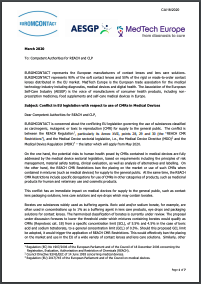Chemycal has been acquired by 3E
Learn MoreChemycal has been acquired by 3E
Learn MoreDiscover how Chemycal PRO helps you boosting your regulatory monitoring:

LETTER SUBMITTED BY INDUSTRY TO EU COMMISSION AND MEMBER STATES AUTHORITIES (CARACAL)
Dear Competent Authorities for REACH and CLP,
EUROMCONTACT is concerned about the conflicting EU legislation governing the use of substances classified as carcinogenic, mutagenic or toxic to reproduction (CMR) for supply to the general public. The conflict is between the REACH Regulation, particularly its Annex XVII, points 28, 29 and 30 (the “REACH CMR Restrictions”), and the Medical Device sectorial legislation, i.e., the Medical Device Directive (MDD) and the Medical Device Regulation (MDR) – the latter which will apply from May 2020.
On the one hand, the potential risks to human health posed by CMRs contained in medical devices are fully
addressed by the medical device sectorial legislation, based on requirements including the principles of risk
management, material safety testing, clinical evaluation, as well as analysis of alternatives and labelling. On
the other hand, the REACH CMR Restrictions ban the placing on the market or use of such CMRs when
contained in mixtures (such as medical devices) for supply to the general public. At the same time, the REACH
CMR Restrictions include specific derogations for use of CMRs in other categories of products, such as medicinal
products for human and veterinary use and cosmetic products.
This conflict has an immediate impact on medical devices for supply to the general public, such as contact lens packaging solutions, lens care solutions and eye drops which may contain borates.
Borates are substances widely used as buffering agents. Boric acid and/or sodium borate, for example, are often used in concentrations up to 1% as a buffering agent in lens care products, eye drops and packaging solutions for contact lenses. The harmonized classification of borates is currently under review. The proposal under discussion foresees to lower the threshold under which mixtures containing borates would qualify as CMRs (Reprotoxic cat. 1B) from a specific concentration limit (SCL), of 5.5% and 4.5% in the case of boric acid and sodium tetraborate, to a general concentration limit (GCL) of 0.3%. Should this proposed GCL limit be adopted, it would trigger the application of REACH CMR Restrictions. This would effectively ban the placing on the market and use in the EU of a wide variety of contact lenses and lens care solutions. Similarly, other categories of medical devices for supply to the general public, such as rewetting drops and lubricating eye drops, would no longer be available to the public.
[...]
2013 © MyChemicalMonitoring. ALL Rights Reserved. About Us | Terms and Conditions